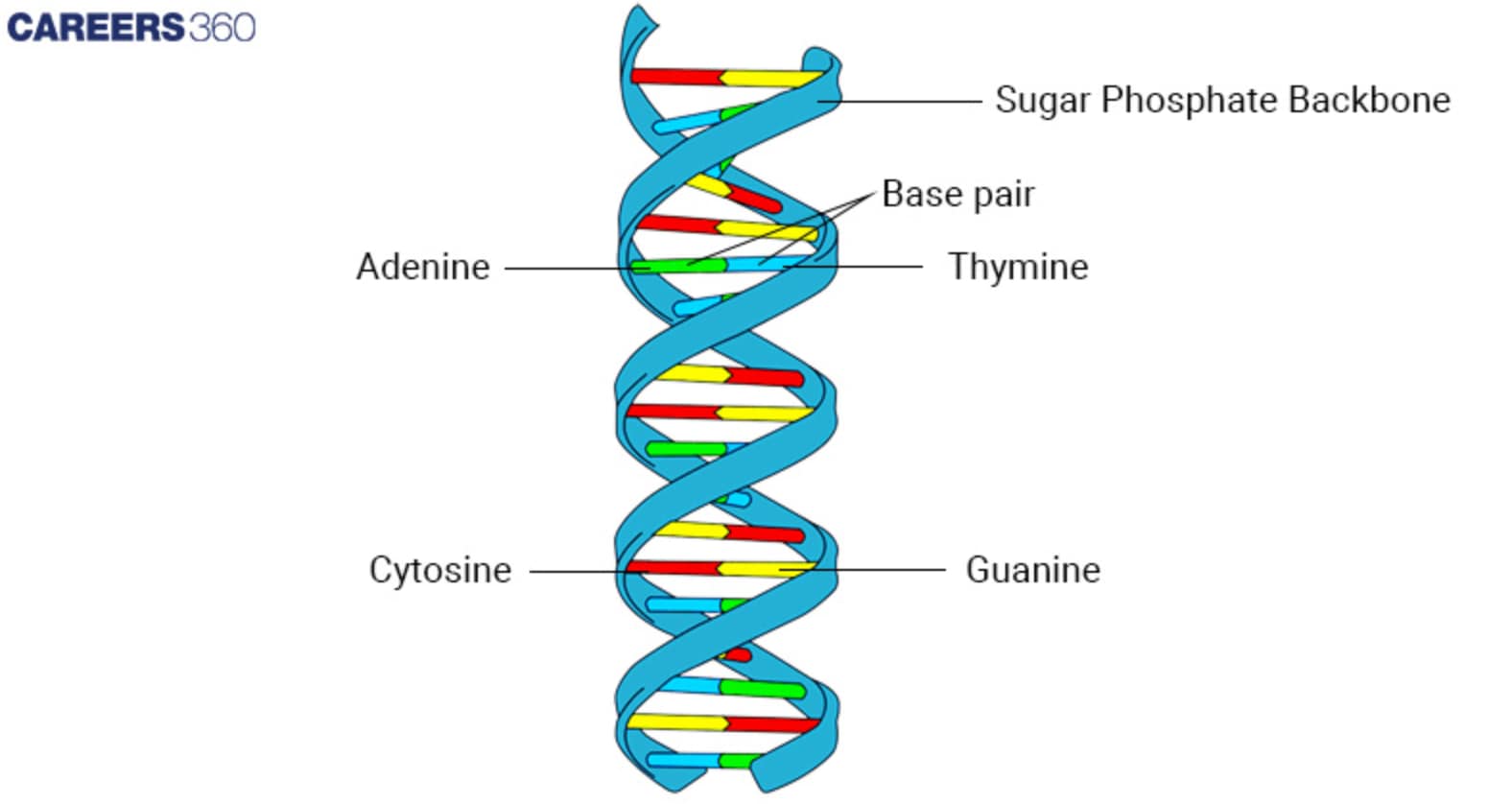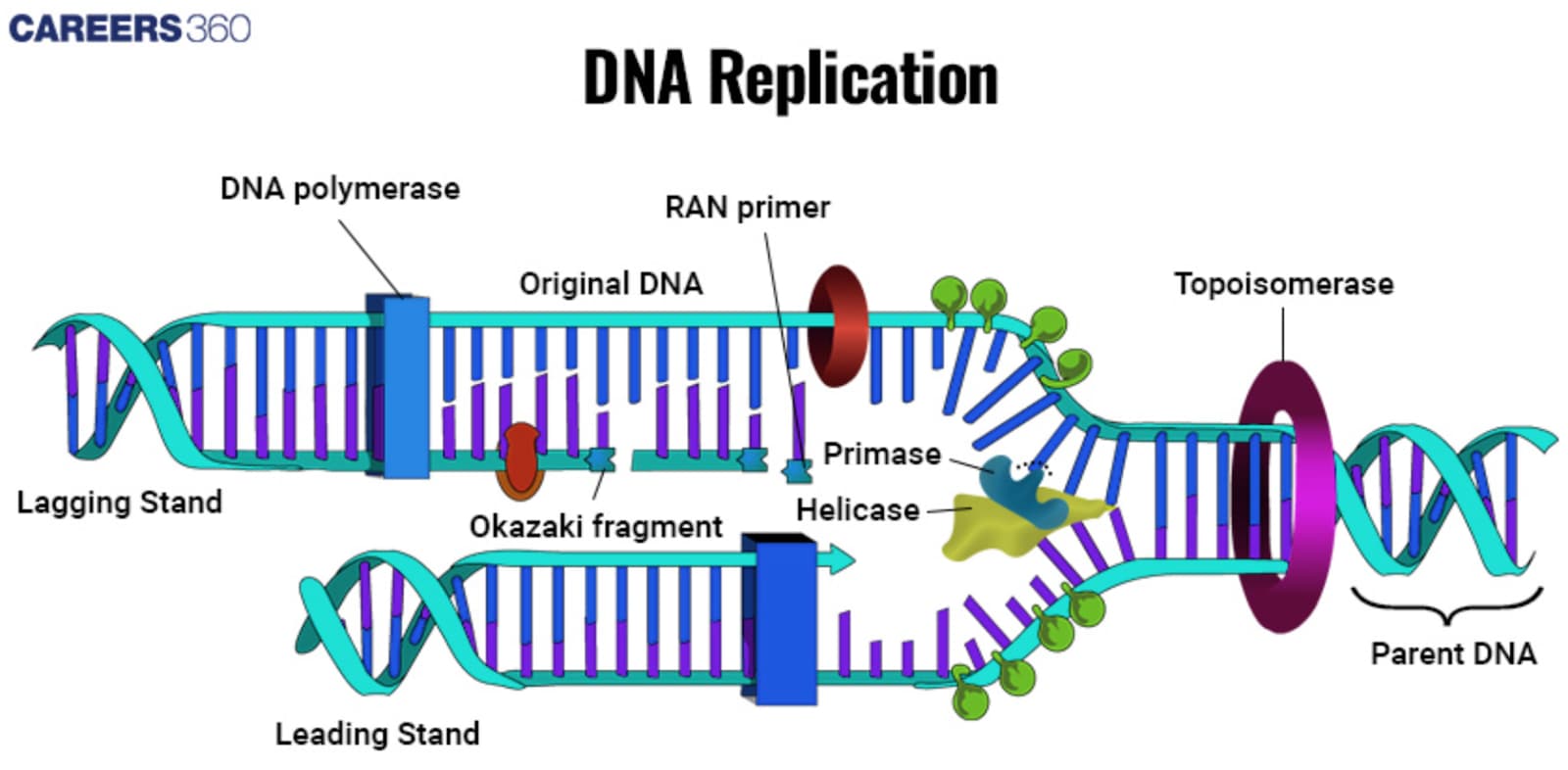DNA: Full Form, Definition Structure, Function, Diagram, Facts, Discovery
DNA (Deoxyribonucleic Acid) is the molecule that carries genetic information essential for growth, development, and reproduction. It is made up of two strands forming a double helix structure, with nucleotides consisting of a sugar, phosphate, and nitrogenous base. DNA contains the instructions for building proteins, which are vital for cellular functions. In this article, DNA, the discovery of DNA, types of DNA, DNA structure, and DNA function are discussed. DNA is a topic of the chapter Molecular Basis of Inheritance in Biology.
NEET 2025: Mock Test Series | Syllabus | High Scoring Topics | PYQs
NEET Important PYQ's Subject wise: Physics | Chemistry | Biology
New: Meet Careers360 B.Tech/NEET Experts in your City | Book your Seat now
- DNA Definition
- What is DNA?
- Who discovered DNA?
- Different forms of DNA
- DNA Structure
- Function of DNA

DNA Definition
DNA is a group of molecules that carry and transmit hereditary materials, or genetic instructions, from parents to offspring.
What is DNA?
DNA full-form: The full form of DNA is Deoxyribonucleic Acid.
DNA meaning: DNA is a molecule that contains the information required for the synthesis of proteins, their functioning, and reproduction. It is made of two long chains spiralled into a double helix in a linear formation made up of nucleotides, which are comprised of sugar-phosphate molecules and nitrogenous bases, namely adenine, thymine, cytosine, and guanine.
DNA is applied by carrying the information that gives an organism its features. In replication and gene expression, DNA is responsible for carrying hereditary traits to future generations. Therefore, DNA is a critical biological molecule contributing to the genetics and molecular biology concepts of population and species variation and the carrying out of these species on earth.
Who discovered DNA?
The distinct double helix structure of DNA was not discovered until 1953 and was formulated by James Watson as well as Francis Crick. The authors of the model used XRD photographs of DNA provided by Rosalind Franklin and Maurice Wilkins. Franklin’s work proved helpful in the characterisation of the molecular conformation of DNA, its being helical, as well as its dimensions.
Discoveries made by Watson, Crick, Franklin, and Wilkins are considered one of the key events in the biological sciences. They identified the structure of DNA molecules, the storage of genetic information and how it can be passed from one generation to another, hence revolutionising genetics, heredity and molecular biology.
Different forms of DNA
DNA has the potential to exist in different conformations, mainly in terms of how the double helix is coiled and the relative positioning of its building blocks.
Here are the main types of DNA structures:
A-DNA:
A-DNA has a right-handed coil and is more compact than B-DNA though it has a longer pitch than B-DNA. It occurs under low humidity conditions or some specific sequences of DNA and RNA. A-DNA has approximately 11 base pairs per turn and is less frequently found in organisms; however, its importance is seen in molecular biology and biotechnology.
B- DNA
This type of DNA is the most common and stable in solutions that mimic the physiological state of the organism. B-DNA is right-handed with a twist of about 10.5. This is the form of DNA seen in most biological processes and interactions.
Z-DNA:
Z-DNA is left-handed and is less common than righthanded B-DNA and A-DNA. It forms under special physiological conditions or when the sequence of bases is separated by purines and pyrimidines in turns. Z-DNA has a zigzag structure of the backbone and is more destabilized than B-DNA and A-DNA. It is involved in gene regulation and it maps in regions of the genome being transcribed.
Also Read-
DNA Structure
The structure of DNA is listed below
Double Helix Model
Explanation of the double helix structure:
The main shape of the DNA molecule is in two chains that are coiled into a helix; a spiral staircase. It is with the help of such a structure that the DNA can compactly store all the genetic information found in it and remain stable.
Contributions of Watson and Crick:
Application of X-ray diffraction came through Rosalind Franklin and Maurice Wilkins whose data supported James Watson and Francis Crick to formulate the DNA double helix in the year 1953. Their model was beautiful in that it was unambiguous in illustrating how genetic information is both coded and copied.
DNA double helix:
The DNA double helix has two antiparallel strands that are connected through hydrogen bonds present between two related nitrogenous bases. In the first strand, adenine is paired with thymine while in the second strand, cytosine is paired with guanine thus making pairing of the base complete.
DNA Structure Diagram

Components of DNA
Nucleotides:
The nucleotides also known as the units of DNA make up the DNA molecule. Each nucleotide contains a phosphate group, a deoxyribose sugar molecule, and one of four nitrogenous bases; adenine, thymine, cytosine or guanine.
Structure of a nucleotide
A nucleotide has three components:
Sugar: In nucleotides, the sugar part can include deoxyribose in the case of DNA or ribose in the case of RNA. This is because; deoxyribose contains one less oxygen atom as compared with ribose, thus making DNA more stable.
Phosphate Group: This group is made of just one phosphorus atom and there, it links four oxygen atoms. It links the sugar moiety of the two adjacent nucleotides forming the backbone of the nucleic acid polymer.
Nitrogenous Base: In nucleotides, nitrogenous bases form four types. In DNA these are adenine (A), thymine (T), cytosine (C) and guanine (G) The bases paired together are A with T and C with G. In RNA, thymine is replaced by uracil, hence RNA has uracil (U) instead of T. These bases are paired particularly (A with T/U, and C with G) to transcribe genetic information.
Hydrogen bonds between bases: Complementary nitrogenous base pairs in DNA hydrogen bond with each other. Adenine has two hydrogen bonds with the molecules of thymine, and cytosine has three hydrogen bonds with guanine. These bonds assist in maintaining the double helix formation of the DNA molecule and also in the unwinding and replication of the DNA molecule during the process of cell division.
Function of DNA
The functions of DNA are discussed below:
Genetic Information Storage
Information in DNA is stored in the form of nucleotide base pairs namely adenine, thymine, cytosine and guanine. These bases pair only (AT and CG), and they create a language or a code that determines how large protein structures and other actions in a cell are to be constructed.
DNA Replication
Semiconservative replication: In the process of DNA replication, one strand of the parent DNA molecule acts as the model against which a new strand is synthesized. This process ensures that in every newly synthesized DNA molecule, of them, one is the old strand and the other a new one.
Enzymes involved:
Key enzymes in DNA replication include:
DNA polymerase: replicates and duplicates DNA and can attach a new nucleotide to the existing chain.
Helicase: negatively impacts the various faces in that it unwinds the double helix of DNA splitting the two strands.
Ligase: joins the newly synthesized Okazaki fragments on the lagging stand.

Transcription and Translation
Process of transcription: Transcription therefore generally means using DNA as a mould to produce RNA. RNA polymerase has an affinity for a segment of the DNA (promoter) to bind to and release two threads of DNA and cause the synthesis of an RNA molecule from one of the DNA threads. There is also the RNA molecule called messenger RNA or mRNA; it can transport the DNA’s genetic information towards the ribosomes.
Process of translation
Translation is the process in which information in mRNA is read to form proteins. It happens in the ribosomes and is the process by which tRNA molecules bring an amino acid to the form and position it according to the nucleotide sequence of mRNA specifying the protein. The ribosome moves along the mRNA sequence reading it in sets of three symbols called codons, which correlate with different amino acids. The building block of a protein is a polypeptide chain that is composed of amino acids and its conformation makes up a functional protein.
Also Read-
| Process of Translation in Biology | Gene Regulation and Gene Expression |
| Genes | Genetic Code And Mutation |
| Gene to Protein - Transcription and Translation | Protein Synthesis |
Recommended Video for DNA
Frequently Asked Questions (FAQs)
As has already mentioned, DNA (Deoxyribonucleic Acid) is the molecule which holds the genetic information in living organisms and it is vital for their inheritance, protein synthesis, work of cells, and even whole organisms.
This process of DNA replication is semiconservative because each of the two original DNA strands serves as a model for the creation of a new strand. Some important enzymes for the note are the DNA polymerase and the helicase that is used in unwinding the double helix and synthesis of new DNA.
It has genes that are the basic units of heredity Information is stored in genes which are present in DNA. Genes are inherited from parents to the new generations through reproduction and determine the traits of the offspring, their characteristics, and certain tendencies to diseases.
Some uses of DNA technology are genetic engineering to alter an organism’s genes, DNA identification for legal issues and for identifying parentage, genomics to study entire sets of genes at one time, genetic prescription medicine for customized treatments depending on one’s makeup and new inventions in biotechnology.
These are changes that occur in the DNA strand; they may be a result of mistakes during replication, exposure to certain conditions including light, certain chemicals, or inherited disorders. Such mutations may cause genetic diseases, changes in the characteristics of organisms or their evolution.
Also Read
29 Nov'24 09:31 AM
19 Nov'24 09:26 AM
18 Nov'24 06:45 PM
18 Nov'24 09:29 AM
18 Nov'24 09:18 AM
18 Nov'24 09:01 AM
18 Nov'24 08:37 AM
16 Nov'24 03:45 PM

